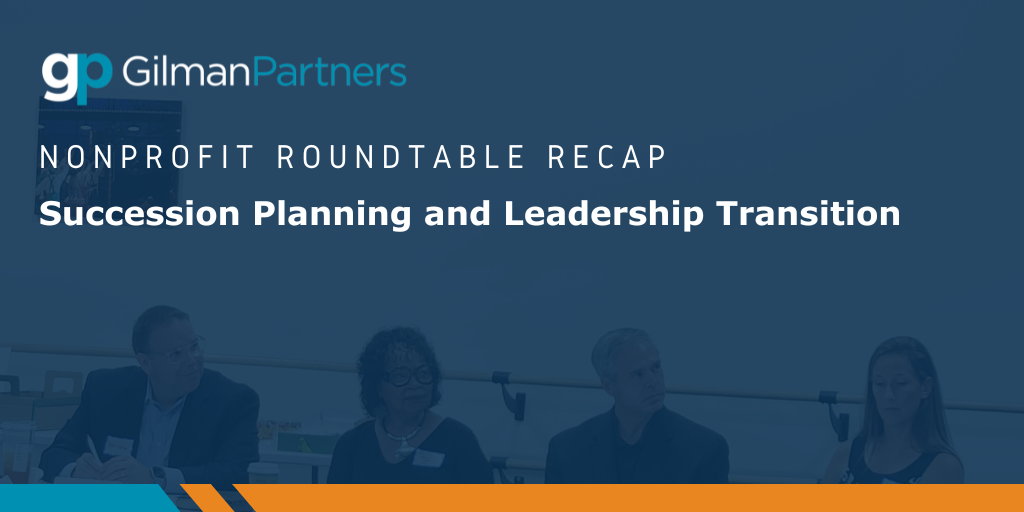Succession planning and finding the right executive leader are crucial steps for nonprofit organizations to ensure their continued effectiveness and impact. Gilman Partners recently hosted our annual nonprofit succession planning roundtable featuring:
- Matthew Randazzo: CEO, Greater Cincinnati Foundation
- Delores Hargrove-Young: Immediate Past Chair, Greater Cincinnati Foundation
- Brad McMonigle: CEO, St. Vincent de Paul Cincinnati
- Alison Zlatic: District Council President/Board Member, St. Vincent de Paul Cincinnati
Here are some valuable insights from our discussion to help guide nonprofit leaders and their Boards through successful transitions.
Start Early
Initiating succession planning well in advance is a key strategy. One panelist stated that it’s never too early to get started and their leadership transition process lasted 14 months. We recommend a two year timeframe for a succession plan, which allows time to conduct an organizational assessment, build and gain consensus on the job description, solidify the priorities of the next CEO/Executive Director and evaluate how those priorities help advance the overall strategic plan. Should the Board decide to conduct an executive search, create a search committee, select the search firm, and begin the search process.
Form a Search Committee with Different Perspectives
It’s advisable to form a search committee with a mix of board members, donors, community representatives, and stakeholders. Include stakeholders who will see things differently but be equally tied to the organization’s mission. The panelists agreed that 5 or 6 people is a good amount to comprise the search committee. Remember that being part of a search committee is a time-consuming commitment, an average of 25-30 hours, so include members who are invested and willing to put in the extra work.
Be Transparent in Your Communication
A well-structured search committee, made up of individuals with diverse viewpoints and deep ties to the mission, can contribute valuable insights. The search committee should communicate with the full board and staff members at regular intervals in the search to keep everyone aware of the process. As one panelist said, “Unmet yet unspoken expectations create toxicity between Board and CEO.” One panelist mentioned the importance of not operating with an “insider’s group” and an “outsider’s group” and emphasized the importance of regular, transparent communication with board members, staff, and donors who are not on the search committee. Periods of transition naturally create uncertainty and people may tend to create their own narratives and wonder, “What does this mean for me?” Even a brief email or short meeting can help maintain transparency. Communicate about the status of the process on a consistent basis while maintaining confidentiality of the candidates.
Enhance the Candidate Experience
The candidate’s experience significantly impacts the success of the search process. Maintain a regular communication cadence with the candidates during the search process to keep them engaged. Time moves very quickly for members of the search committee but to a candidate, a week can feel like an eternity. Without regular updates and connection, they may look for other opportunities. Provide regular feedback to candidates, as this builds trust and fosters positive relationships. Our panelists repeatedly agreed that feedback is a gift.
It’s just as important to be transparent when appointing an interim leader. Communicate expectations and if the interim leader is not a candidate for the permanent position, make sure they know this from the start to avoid confusion and potential conflicts.
Embrace a Human Capital Strategy for Staff
One panelist noted that leaders should analyze the marketplace of talent inside their organization and develop a strategy that focuses on succession planning for all leadership positions, not just the CEO. He mentioned that when a CEO’s time with the organization comes to an end, one measure of success is saying to the board, “Here is our bench of possible successors and these are the players we’ve been coaching and developing for the last decade.”
Succession planning and conducting an executive leadership search is a complex yet pivotal process for nonprofit organizations. By embracing transparency, engaging diverse perspectives, and investing in human capital, nonprofits can ensure seamless transitions that empower the organization to thrive and fulfill its mission for years to come. Succession planning is not just about finding the next leader; it’s about securing the future of the organization itself.




